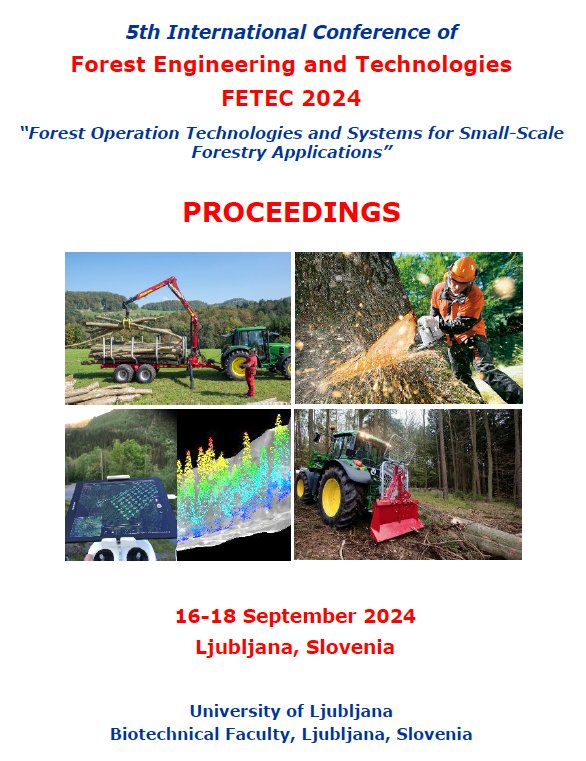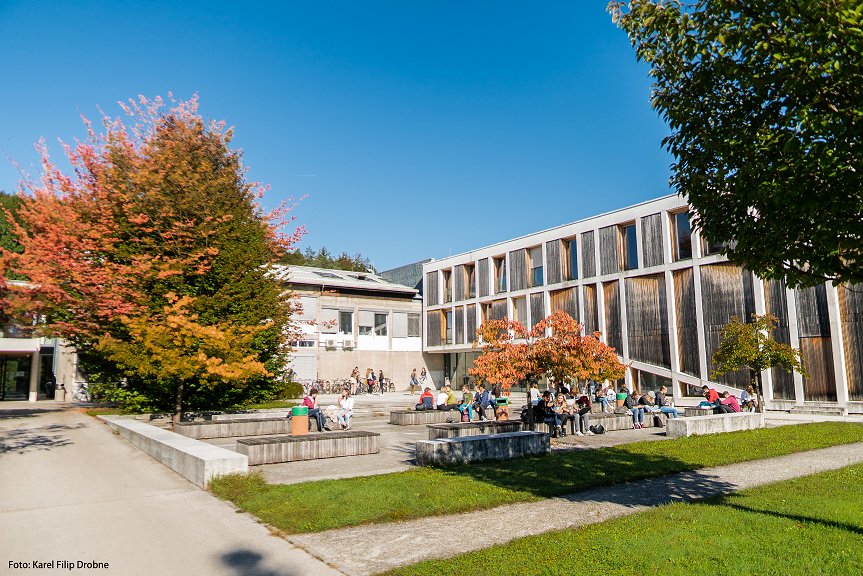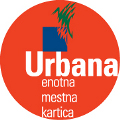Internatıonal Conference of FETEC 2024 Ljubljana, Slovenıa 16-18 Sept. 2024
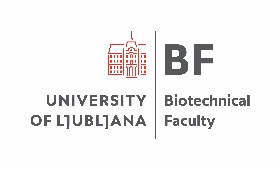

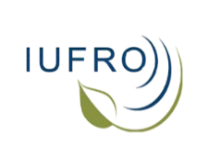
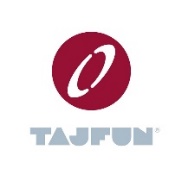
5th International Conference of
Forest Engineering and Technologies-FETEC 2024
“Forest Operation Technologies and Systems for Small-Scale Forestry Applications”
16-18 September 2024
Ljubljana, Slovenia
University of Ljubljana, Biotechnical Faculty, Ljubljana, Slovenia
https://www.ormantransportu.org/fetec2024
Conference Rationale
Forestry plays a crucial role in the ecosystem, maintaining biodiversity, providing habitats, regulating the water cycle, and serving as a carbon sink to mitigate the effects of climate change. The forest resources should be managed according to principles of sustainable and close to nature forest management in order to meet needs of today’s and future’s generations. These two approaches aim to maximize the benefits of forests and to minimize environmental damages by using modern techniques and technological tools in forestry activities. Particularly, forest operations producing wood-based forest products should abide to the precision forestry approach. In recent decades, advanced small-scale forest operations, which are used in non-industrial and site-specific forestry, provide alternative methods well suited for use with precision forestry concept. Besides, small-scale forestry significantly contributes to the bio-economy through forest-based businesses, rural communities, and provision of multiple ecosystem services in many regions of the world. Small-scale harvesting machines have low initial cost and relatively low operating cost, while at the same time, their potential environmental impacts can be considerably lower than with use of large scale machinery.
5th International Conference of Forest Engineering and Technologies (FETEC 2024): “Forest operation technologies and systems for small-scale forestry applications” will be organized on 16-18 September 2024 by University of Ljubljana, Biotechnical Faculty in the city of Ljubljana, Slovenia. The conference co-organizers include FETEC Platform and IUFRO Division 3.01 The sponsor of FETEC2024 is Tajfun LLC.

Conference Objective
The aim of the conference is to discuss the most recent scientific and professional research related to forest operation technologies and systems for small-scale forestry applications with attendance of internationally renowned researchers, practitioners, and relevant shareholders.
Conference Topics
- Planning, organization and implementation of small-scale logging and transportation activities
- Forest operations in private forests
- Small-scale forestry based enterprises in rural communities
- Small-scale logging machinery
- Forest mechanization-trends in small-scale operations
- Economic sustainability of small-scale forestry
- Forest bioenergy challenges in small-scale forestry sector
- Work safety and ergonomics in forest engineering
- Assessment of stand damage and soil impact from small-scale logging
- Implementation of smart forestry (GIS, ICT, IoT, etc.) in small-scale forest operations
- Using remote sensing data (UAV, LiDAR, etc.) and machine learning in small-scale forestry
- Forest roads and road infrastructure in small-scale forestry

Organizational Committee
Assoc.Prof.Dr. Matevž Mihelič (Chair), University of Ljubljana, Biotechnical faculty, Slovenia
Prof.Dr. H.Hulusi Acar (Co-Chair), FETEC, Istanbul Yeni Yüzyıl University, Istanbul, Turkiye
Prof.Dr. Abdullah E. Akay, IUFRO Division 3.01, Bursa Technical University, Bursa, Turkiye
Assoc.Prof.Dr. Raffaele Spinelli, IBE-CNR, Italy
Prof.Dr. Janez Krč, University of Ljubljana, Biotechnical Faculty, Slovenia
Mateja Intihar, University of Ljubljana, Biotechnical Faculty, Slovenia
Luka Pajek, University of Ljubljana, Biotechnical Faculty Ljubljana, Slovenia
Conference Sponsor
Tajfun LLC., Planina pri Sevnici, Slovenia
Scientific Committee
Abdullah E. Akay (Chair), BTU, Bursa, Turkiye
H.Hulusi Acar, IYYU, Istanbul, Turkiye
Mario Acuna, NRIF, Helsinki, Finland
Dzhamal Amishev, LU, Canada
Burak Arıcak, BTU, Bursa, Turkiye
Kazuhiro Aruga, UDAI, Utsunomiya, Japan
Ayhan Ateşoğlu, BU, Bartın, Turkiye
Abdurrahim Aydın, DU, Düzce, Turkiye
Borys Bakay, UNFU, Lviv, Ukraine
Erhan Çalışkan, KTU, Trabzon, Turkiye
Oğuz Çoban, IUAS, Isparta, Turkiye
Milorad Danilović, UB, Belgrad, Serbia
Murat Demir, IU-C, Istanbul, Turkiye
Andreja Đuka, UZ, Zagreb, Croatia
Mehmet Eker, IUAS, Isparta, Turkiye
Seca Gandeseca, UP, Sarawak, Malaysia
M. Reza Ghaffariyan, USC, Q. Land, Australia
Peter Gorsevski, BGSU, OH, USA
Stefano Grigolato, UNIPD, Padova, Italy
Selçuk Gümüş, KTU, Trabzon, Turkiye
Velid Halilović, US, Bosnia & Herzegovina
Han Sup Han, NAU, Arizona, USA
Hajri Haska, UMT, Tirana, Albania
Hans R. Heinimann, ETH, Zurich, Switzerland
Zbigniew Karaszewski, LPIT, Poznan, Poland
Kalle Karha, UEFC, Joensuu, Kuopio, Finland
Robert Keefe, UI, Idaho, USA
Ayhan Koç, IU-C, Istanbul, Turkiye
Ola Lindroos, SLU, Umea, Sweden
Majid Lotfalian, SANRU, Sari, Iran
Natascia Magagnotti, IBE-CNR, Firenze, Italy
Piotr S. Mederski, PULS, Poznań, Poland
Matevž Mihelič, UL,BF, Ljubljana, Slovenia
Tadeusz Moskalik, SGGW, Warsaw, Poland
Ramin Naghdi, UG, Guilan, Iran
Ljupco Nestorovski, UKMS, Skopje, N.Macedonia
Tolga Öztürk, IU-C, Istanbul, Turkiye
Vladimir Petković, UBL, Bosnia & Herzegovina
Abdurasul Pirnazarov, NIET, Uzbekistan
Igor Potočnik, UL, Ljubljana, Slovenia
Anton Poje, UL, Ljubljana, Slovenia
Thomas Purfürst, UF, Freiburg, Germany
Hideo Sakai, UT, Tokyo, Japan
Dzevada Sokolovic, US, Bosnia & Herzegovina
Raffaele Spinelli, IBE-CNR, Firenze, Italy
Ben Spong, WVU, WV, USA
Karl Stampfer, BOKU, Vienna, Austria
Oleg Styranivsky, UNFU, Lviv, Ukraine
Bogdan Strimbu, OSU, Oregon, USA
Petros A. Tsioras AUTH, Thesaloniki, Greece
Metin Tunay, BU, Bartın, Turkiye
Tuğrul Varol, BU, Bartın, Turkiye
Rien Visser, UC, Christchurch, New Zealand
Rezo Vasadze, BSRU, Batumi, Georgia
Dinko Vusić, UZ, Zagreb, Croatia
Aydin Yahyayev, WCU, Baku, Azerbaijan
Hakan Yener, IU-C, Istanbul, Turkiye
Tetsuhiko Yoshimura, SU, Shimane, Japan
Secretarial and Contact
Luka Pajek, UL, BF, Ljubljana, Slovenia
E-mail: fetec2024@bf.uni-lj.si
Assist.Prof.Dr. İnanç Taş, BTU, Bursa, Turkiye
E-mail: inanc.tas@btu.edu.tr

Book of Abstracts
FETEC 2024 Book of Abstracts can be downloded using the link below:
Important Dates
|
Abstract Submission: Author Notification: Registration: Full Paper Submission: Publication of Proceedings: |
15 July 2024 15 Augt. 2024 30 Augt. 2024 15 Oct. 2024 15 Nov. 2 024 |

5th International Conference of
Forest Engineering and Technologies-FETEC 2024
“Forest Operation Technologies and Systems for
Small-Scale Forestry Applications”
16-18 September 2024
Ljubljana, Slovenia



* The bus will be leaving the site of conference every day and taking participants back to the shuttle space.



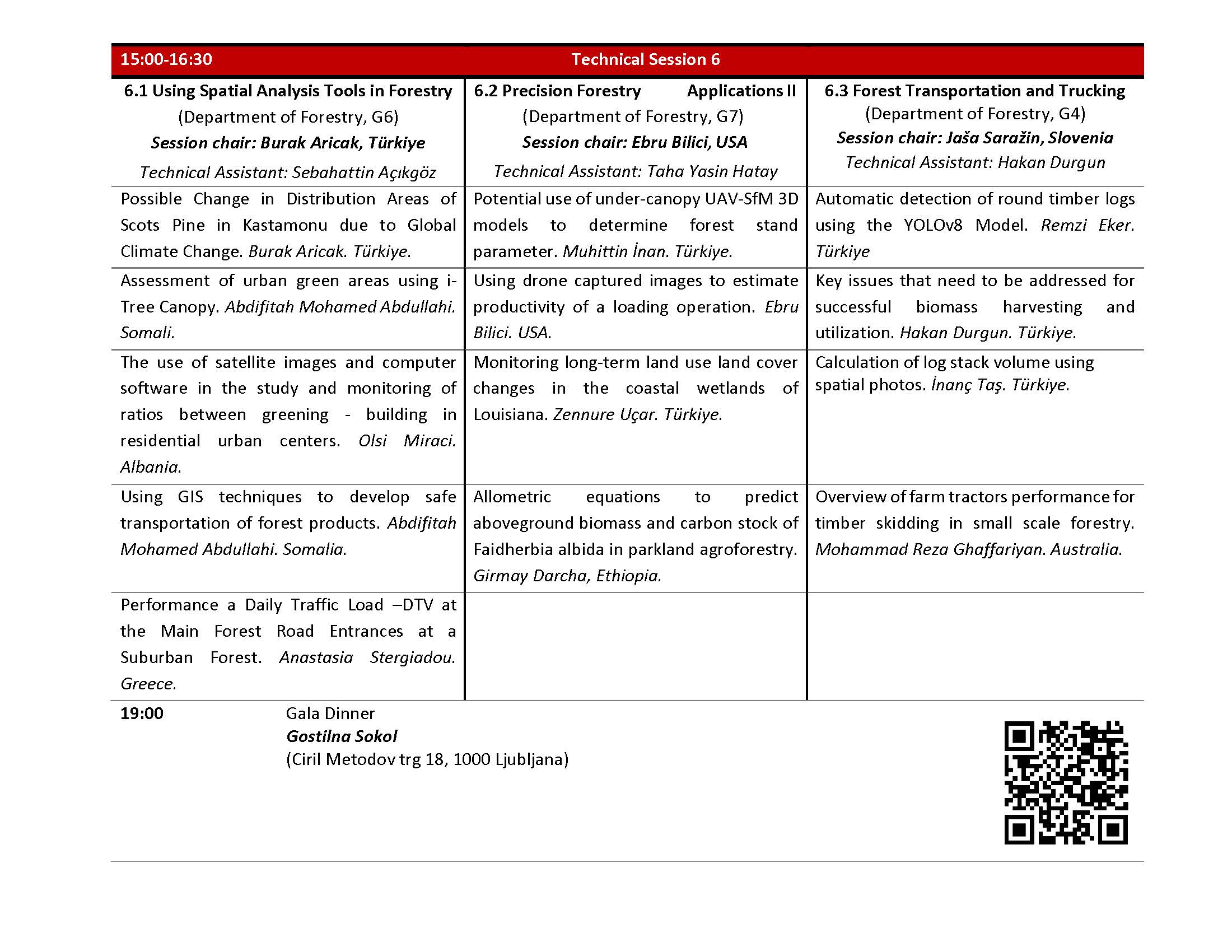
* The bus will be leaving the site of conference every day and taking participants back to the shuttle space.

* The bus will be leaving the site of conference every day and taking participants back to the shuttle space.

Abstract Submission Instructions
The abstract should include150-200 words. Please, briefly explain the aim and scope of your study, your materials and methods, and the main conclusions of the study. Font should be Times New Roman, font size 12 pt. The abstract should not include any figures, tables or extra headers. The abstract must be submitted in Microsoft Office Word. Up to five keywords (separate with comma) should be added at the end of the abstarct. Please indicate the type of presentation (oral/poster) as you submit the abstract. Abstracts will be evaluated by the referees from the Scientific Committee.
Template of the abstract can be downloaded from here.
High-quality papers will be considered to be published in the European Journal Forest Engineering or ACTA Silvae et Ligni.
*If you prefer to submit you Abstract via e-mail please sent your Abstract to fetec2024@bf.uni-lj.si with presentation preferences (oral/poster).
Submit Abstract

Full Paper Submission Instructions
Papers of both Oral and Poster presentations should be written on page format of DIN A4 (210 x 297 mm), all margins of 2.5 cm, font size of 12 pt, and font type of Times New Roman. Text should be written in single space and should not exceed 10 pages (including tables, figures, and references). Page numbers should be consecutively located in the bottom right corner.
Template of full paper can be downloaded from here.
Full papers should be sent to fetec2024@bf.uni-lj.si by 15 October, 2024.
TITLE PAGE
Title should be written in capital letters and bold format. After title, author name(s) and the address (affiliations, telephone, fax and e-mail address) should also be supplied. For papers with more than one author, the corresponding author should be indicated with a sign*.
ABSTRACT
Abstract should contain short and sufficient information about study rationale, objectives, materials and methods used in, the results obtained and suggestions, and should be limited by maximum 200 words. There should be 3-5 key words provided after the abstract.
MAIN TEXT
Main text of the paper is the section where detail information about the study is provided. Headings should be numbered as 1, 1.1, 1.1.1 in this section. Main headings such as INTRODUCTION, MATERIAL AND METHODS, RESULTS AND DISCUSSION, CONCLUSION AND SUGGESTIONS should be written in capital letters, bold format, and left-justified. Subheadings should be also in bold format and left-justified, but only initial letters should be in capital letters. Main text should be written in plain format without any special format, and there should be single line spacing between paragraphs.
TABLES AND FIGURES
Tables and figures should be located in the most appropriate place just after they are referred in the text and consecutively numbered (1, 2, 3, …). Table captions should be placed above the tables while they should be placed below figures. Vertical grid lines should not be used in tables.
REFERENCES
References mentioned in the text should be written in parenthesis as “author’s last name, publication year”. If there is more than one reference, they should be chronologically ordered and separated by semicolon (Example: Allen and Fox, 1998; Yıldırım et al., 2002).
In References section at the end of a paper, they should be listed according to alphabetical order of authors’ last names, and then according to chronological order of publication dates for the references of the same authors. If there is more than one reference published by the same authors in the same year, they should be indicated by including annex in alphabetical order (Example: 1993a).
Main format to be used for references at the end of paper should be: Author name (last name, name), publication year (and annex if necessary), title, journal name, volume, number, and page numbers. If the reference is a book, publishing house and location should be indicated, while name, date, and location of a symposium should be also given for symposium proceedings. Some examples are given below about presentation of references:
Journal article:
Akay, A.E., Wing, M., Sessions J. 2012. Estimating structural properties of riparian forests with airborne LiDAR data. International Journal of Remote Sensing. 33(22): 7010-7023.
Book:
Sessions, J., Boston, K., Wing, M.G., Akay, A.E., Theisen, P., Heinrich, R. 2007. Forest Road Operations in the Tropics. Edited by Sessions, J. Springer, Berlin. 170 p.
Congress and symposium:
Akay, A.E., Kılıç, E.H. 2015. Providing Engineering Solutions to Forest Fire Access Problems Using Network Analysis Method. International Conference on Engineering and Natural Sciences (ICENS) 2015. 15-19 May. Skopje (Üsküp), N.Macedonia.
Registration
Please fill out the following Registration Form inquring information about your participation to FETEC 2024.These information will help us to ensure that the event runs smoothly and stays on schedule. Thank you for your cooperation and see you in Ljubljana!
Bank account information is given below for registration fee of 100 euro which will cover conference documents and other expenses.
At least one author per abstract must be registered.
PAYMENT ACCOUNT DETAILS:
IBAN: SI56 0110 0603 0707 410
SWIFT: BSLJSI2X (Banka Slovenije)
Reference number: SI00 13402016
Account holder name: University of Ljubljana, Biotechnical faculty.
Address: University of Ljubljana, Biotechnical Faculty,
Jamnikarjeva 101, 1000 Ljubljana, Slovenia
Please add your name and surname onto the payment form.
After payment, please send payment receipt to fetec2024@bf.uni-lj.si with the subject of "FETEC2024 Fee".

| Travel and Accommodation | ||
|
1) Conference venue: First day: University of Ljubljana, Biotechnical Faculty, Jamnikarjeva 101, 1000 Ljubljana; Classroom D1 Second day: University of Ljubljana, Biotechnical Faculty, Department of Forestry and Renewable Forest Resources, Večna pot 83, 1000 Ljubljana. ">">
|
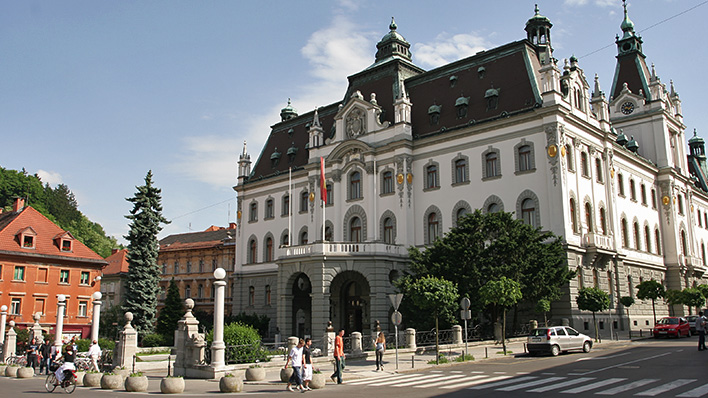 |
|
|
|
||
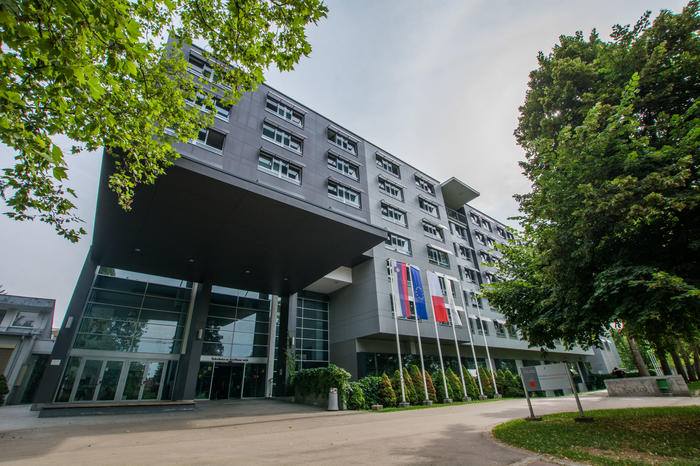 |
||
2) Accommodation:
- Special rates are being held at the City Hotel and B&B HOTEL Ljubljana Park.
- Please book your rooms prior to August 1, 2024, and keep in mind that there are a lot of conferences and evenst in September in Ljubljana.
- The bus trasport will be provided from these hotels to the conference venue every day.
|
City Hotel City Hotel is located in the heart of Ljubljana, one of the most relaxed capitals in the world, where castles and dragons rub shoulders with trendy coffee shops and a lively night life. City Hotel Ljubljana is a 4-star hotel and offers 207 comfortable rooms where you can rest after a busy day of exploring the capital. The hotel is easily accessible from all main roads entering the city. It is located right where the traffic-free area begins and is easily accessible by a car. Price: 10% discount with promotion code of "FETEC24" Reservation: https://www.cityhotel.si/en/ |
|
|
B&B HOTEL Ljubljana Park B&B Hotel Ljubljana Park is an excellent starting point for exploring the green capital of Slovenia. After a busy day of exploring, business meetings or conferences, you can refill your batteries in comfortably furnished rooms. B&B Hotel Ljubljana Park the most urban and green hotel in the center of Ljubljana is a hotel surrounded by parks, cultural and artistic vibes. The hotel is located in the very center of Ljubljana and close to the main train and bus station. Calm and peaceful location, great for relaxing. Price: 10% discount with promotion code of "FETEC2024"
Reservation: https://www.hotel-bb.com/en/hotel/ljubljana-park |
3) How to get there?
- By plane
At Ljubljana Airport take either the bus at the bus station near Passenger Terminal A in the direction Ljubljana Central Bus & Train station.
At the Central Bus & Train station take the bus number 18 towards "CENTER STOŽICE P+R" and get off at the bus station "VEČNA POT".
The venue is just at the other side of the street, a yellow building with address Večna pot 83.
- By bus/train
Both busses and trains arrive at the Central Bus & Train station, from where you take the bus number 18 towards "CENTER STOŽICE P+R" and get off at the bus station "VEČNA POT".
The venue is just at the other side of the street, a yellow building with address Večna pot 83.
- By car
Arrival from South: on highway A2/E70 take the exit "35 Ljubljana-zahod" and follow street "Pot Rdečega križa" and then continue forward on street "Pot za Brdom". At the crossroad then turn right and continue along on street "Pot Roberta Blinca" till a crossroad, when turn right on "Večna pot". Continue for 1,5 km to the venue on the right. Parking places are granted near the Faculty building.
Arrival from North: on highway A2/E70 take the exit "16 Ljubljana-Brdo / ZOO" and follow street "Pot za Brdom". At the crossroad then turn left and continue along on street "Pot Roberta Blinca" till a crossroad, when turn right on "Večna pot". Continue for 1,5 km to the venue on the right. Parking places are granted near the Faculty building.
|
4) Public city transport: Public city transport is possible using Urbana card or using Urbana mobile application. Urbana card (no-contact smart card) and Urbana App allow quick and convenient cash-free payment for rides on all LPP (city bus) lines. The Urbana card enables you a free-of-charge switching of buses within 90 minutes from the time of the first validation i.e. payment of the ride. If you do not use Urbana, the card is outdated after three years. The Urbana card can except for the buses also be used to pay for EURBAN (train which takes you to Ljubljana Castle), for cable-car rides to the Ljubljana Castle, tickets for all events at the Ljubljana Castle, parking fees for white zones and parking lots managed by Javno podjetje Ljubljanska parkirišča in tržnice. |
|
Using Urbana mobile App
The application is available in the online stores Google Play and App Store. The app is called Urbana and it uses the same logo.
Additional information are available at: https://www.lpp.si/sites/www.jhl.si/files/dokumenti/instructions_for_the_new_urbana_application_3.pdf
Using Urbana card
You can purchase and top-up Urbana value card:
- at green stand-alone machines or Urbanomats which are mostly found near bus stops,
- at LPP Info Point (Slovenska cesta 56, 1000 Ljubljana),
- at Ljubljana Bus Station,
- in larger shopping centres Mercator and Spar,
- at selected Petrol stations,
- at selected offices of Pošta Slovenija,
- at newsagents’ and tobacconists’,
- at Tourist Information Centres.
Prices: One fare (including interchanging buses or not within 90 minutes) is 1.30€.
Note that this information refers to public transportation in Ljubljana for ZONE 1, which is all you will probably need (except if you plan to go in the suburbs or other cities). Please don’t forget to validate your URBANA when entering a bus!


